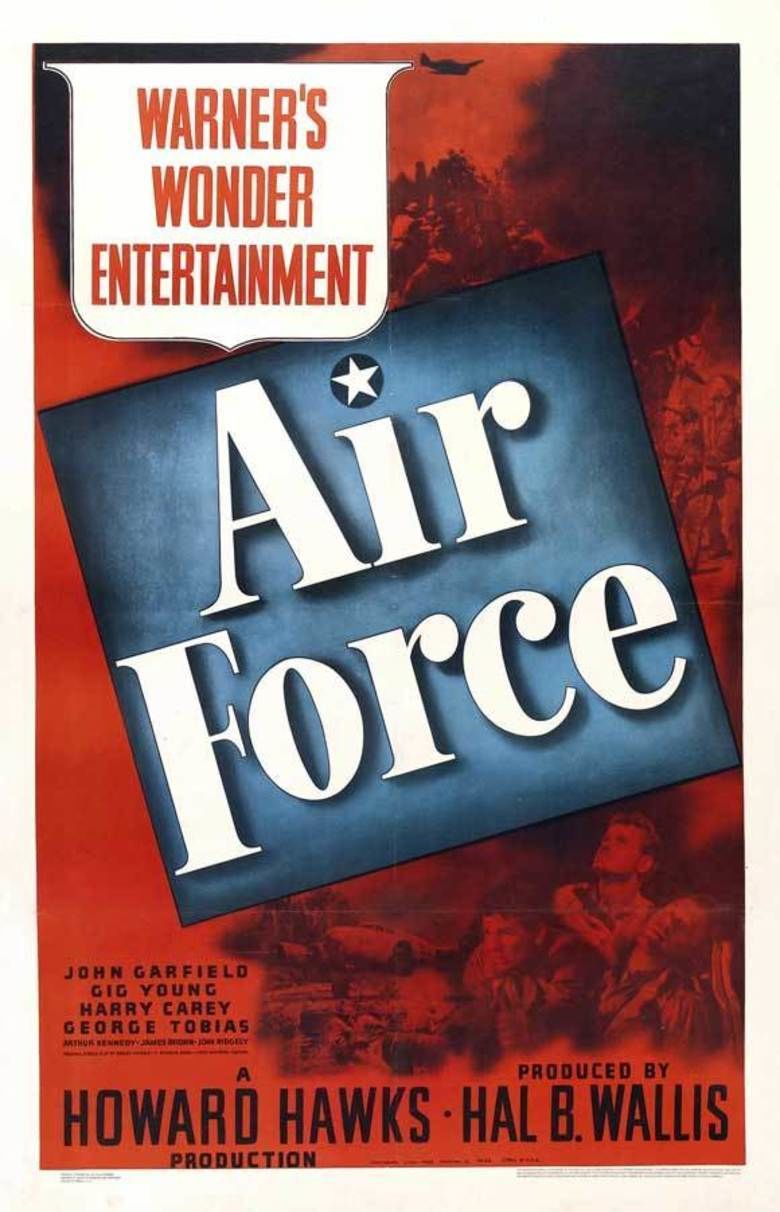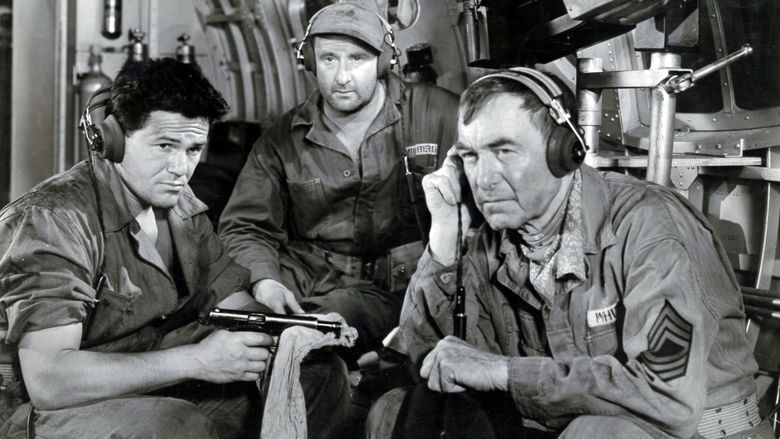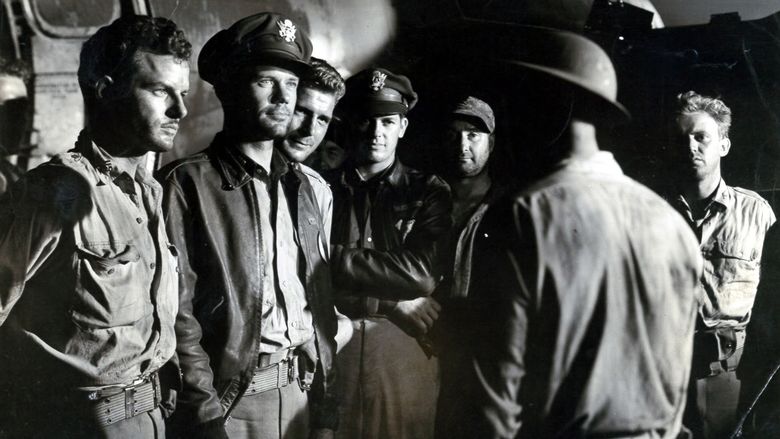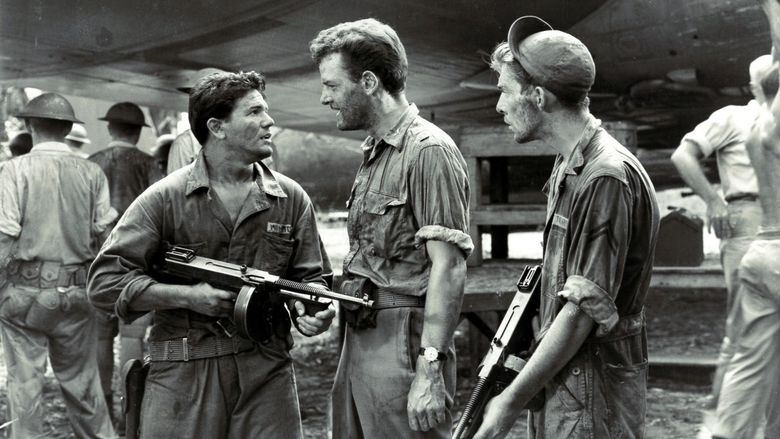Air Force (film)
7.8 /10 1 Votes7.8
88% Rotten Tomatoes Duration Language English | 7.1/10 IMDb 7.2/10 Letterboxd Genre Action, Drama, History Country United States | |||||||||||||||||||||||||||||||||
 | ||||||||||||||||||||||||||||||||||
Release date February 3, 1943 (1943-02-03) Initial release February 3, 1943 (New York City) Cast (Pilot), (Co-Pilot), Arthur Kennedy (Bombardier), (Navigator), (Crew Chief), (Asst. Crew Chief)Similar movies Good Morning, Vietnam , Forever Young , Hamburger Hill , Twelve O'Clock High , Flying Leathernecks , Strategic Air Command Tagline GIANTS OF THE SKY...blazing a trail to victory! | ||||||||||||||||||||||||||||||||||
Air Force is a 1943 American black-and-white World War II aviation film from Warner Bros., produced by Hal B. Wallis and Jack L. Warner, directed by Howard Hawks, that stars John Garfield, John Ridgely, Gig Young, Arthur Kennedy, and Harry Carey. Made in the aftermath of the Pearl Harbor attack, it was one of the first of the patriotic films of the war, often characterized as a propaganda film.
Contents
- Plot
- Cast
- Production
- Aircraft
- Historical accuracy
- Reception
- Awards and nominations
- Radio adaptation
- References

The story revolves around an actual incident that occurred on December 7, 1941. An aircrew is ferrying an unarmed Boeing B-17 Flying Fortress heavy bomber named the Mary-Ann across the Pacific to the United States Army Air Corps base at Hickam Field when they fly right into the middle of the Japanese air attack on Pearl Harbor and the beginning of America's direct involvement in World War II. An uncredited William Faulkner wrote the emotional deathbed scene for Ridgely, who played the pilot of the Mary-Ann.

Plot

On December 6, 1941, at Hamilton Field, near San Francisco, a United States Army Air Corps B-17D bomber named the Mary-Ann and its crew are being readied for a flight across the Pacific.

Master Sergeant Robbie White (Harry Carey), the Mary-Ann's crew chief, is a long-time veteran in the Army Air Corps, whose son, Danny White is a West Point graduate, an officer, and a pilot. The navigator, Lt. Monk Hauser Jr. (Charles Drake), is the son of a World War I hero of the Lafayette Escadrille. The pilot is Michael Aloysius "Irish" Quincannon Sr. (John Ridgely), the co-pilot is Bill Williams (Gig Young) and the bombardier, Tom McMartin (Arthur Kennedy). Sergeant Joe Winocki (John Garfield) is a disgruntled gunner who, as an aviation cadet in 1938, washed out of flight school after he was involved in a mid-air collision in which another cadet was killed. Quincannon was the flight instructor who requested that the board of inquiry dismiss Winocki. The navigator and bombardier also washed out of pilot training.
With the United States at peace, the Mary-Ann and the rest of its squadron are ordered to fly without ammunition to Hickam Field at Pearl Harbor, Territory of Hawaii. As it happens, the Mary-Ann flies right into the Japanese sneak attack on Pearl Harbor on December 7, 1941. In its aftermath, the beleaguered B-17 crew is taxed to the limit, as they are ordered on, with little rest, first to Wake Island, and then on to Clark Field in the Philippines; both locations have also come under heavy Japanese attack. While en route, the crew listens to President Franklin D. Roosevelt ask Congress for a declaration of war. They take along two passengers to Clark Field: fighter pilot Lt. Thomas "Tex" Rader (James Brown) and a small dog, "Tripoli", the Marines mascot on Wake Island, to be given to their Marine counterparts.
When they land at Clark Field, White learns that his son was killed on the first day trying to lead his squadron into the air. Soon after, Quincannon volunteers his bomber for a one-aircraft mission against a Japanese invasion fleet, but the Mary-Ann is attacked by enemy fighters and forced to abort. The badly wounded Quincannon orders his men to bail out, but then blacks out. Winocki sees he has passed out and remains aboard to make a belly landing, being unable to lower the landing gear.
Having told a dying Quincannon that the Mary-Ann is ready to fly, the crew works feverishly through the night to repair their bomber with parts from B-17 wrecks, as the Japanese Army closes in. Private Chester volunteers to fly as gunner in a two-seat fighter aircraft defending Clark Field. In aerial combat, the pilot is killed and Chester is forced to bail out; he is machine-gunned by a Japanese fighter pilot while descending helpless in his parachute. The same aircraft strafes Chester on the ground, leaving behind a lifeless body. Winocki and White shoot down the fighter. When the armed pilot stumbles from his burning wreckage, a furious Winocki machine-guns him repeatedly. The exhausted aircrew barely manages to finish their repairs as the airfield comes under close ground attack. With the help of the Marines and Army soldiers, the Mary-Ann's refueling is done, while her machine guns are returning fire, and she takes to the skies once again.
As their B-17 heads for Australia, with Rader as a now reluctant bomber pilot and the wounded Williams as co-pilot, they spot a large Japanese naval invasion task force below. The crew radios the enemy's position and circles until reinforcements arrive; the Mary-Ann then leads the bombing attack that destroys the Japanese fleet (the missions portrayed in these Coral Sea sequences mirror real-life events).
In the final scene, a bombing attack on Tokyo is finally announced to a roomful of bomber crews, among them several familiar faces from the Mary-Ann, including Rader, now a B-17 pilot. As their aircraft take off, President Roosevelt words are heard in a stirring voice-over, while the assembled air armada heads towards the rising sun and victory.
Cast
As appearing in screen credits (main roles identified):
Production
Director Howard Hawks credited the concept of the film to Lt. Gen. Henry H. Arnold, Commanding General of the Army Air Forces, based on the experiences of a flight of B-17s that left Hamilton Field, California, on the night of December 6, 1941, and literally flew into the war the next morning at Pearl Harbor. Executive producer Jack Warner was adamant that the film be ready for release by December 7, 1942, the first anniversary of the attack on Pearl Harbor. To that end, miniatures for battle sequences were filmed in May and June 1942, before completion of the script and storyline.
Although pre-production work on Air Force had already taken place, the official start of the production on May 18, 1942, was tied to the War Department approving the script. Development of the film was concurrent with script-writing by Dudley Nichols, with some characters based on Air Corps personnel Hawks met while traveling to Washington, D.C., to confer with Arnold and the War Department Motion Picture Board of Review. Nichols's script, submitted June 15, was 207 pages in length (twice that of the normal feature-length film), had its initial 55 pages devoted to "character development," and was not finished.
Principal photography for Air Force, consisting of aerial shots and exteriors, took place at Hendricks Army Airfield, Florida. For water scenes and shooting miniatures shots, MacDill Field, Florida, Randolph Field, Texas, and Santa Monica Bay, California, were used. Shooting began June 18, 1942, using a rented mock-up of a B-17 interior, in which the 10 principal characters performed for a month. The company then moved by train to Drew Army Air Field, Florida, at the end of July, to spend the next month shooting aerial sequences coordinated by Paul Mantz, chief pilot and aerial technical coordinator for the production. Drew was selected because of fears that use of aircraft marked as Japanese might cause panic on the West Coast.
At the end of August, Hawks returned to Hollywood and engaged William Faulkner to rewrite two scenes for Air Force, including the death of the Mary-Ann's pilot. By then, the film, scheduled to be completed by September 17, was three weeks behind schedule and only half completed. Production featured a celebrated clash between producer Hall Wallis and Hawks over the latter's constant changing of dialogue as scenes were shot. Hawks was briefly replaced on October 4 by Vincent Sherman, but returned from "illness" on October 10 to take back primary direction. Sherman remained as second unit director to assist with completion of the picture, which wrapped on October 26, 1942, failing to shoot 43 pages of script and 33 days over schedule, too late to meet its December 7 release date.
Wallis wrote that AAF Captains Sam P. Triffy and Hewett T. Wheless were technical advisors to the film, and that Triffy in particular made significant contributions to the storyline, dialogue, and sets. "Shorty" Wheless had previously been a B-17 aircraft commander in the Philippines with the 19th Bomb Group and had been one of the survivors evacuated to Australia in December 1941. He was at Randolph Field, Texas, in the process of appearing as himself in the Academy Award-winning short film Beyond the Line of Duty when he assisted on Air Force.
Aircraft
The U. S. Army Air Forces provided the various aircraft that appear in the film:
The real Mary-Ann was reported lost in the Pacific shortly after the film production wrapped, according to information attributed to the production's technical advisor; actually, no early Flying Fortresses served for long in Pacific combat after Pearl Harbor. Another claim, attributed to a newspaper article, was that "the real Mary-Ann "went on tour to promote the film, then was assigned to Hobbs Army Air Field, New Mexico, then later to Amarillo Army Air Field, where it was assigned to a ground school. Two early B-17B aircraft, upgraded to the later model "D" standards, played the role of Mary Ann; AAF serial numbers 38-584 and 39-10 (briefly seen in background projection as John Garfield boards the aircraft) were reclassified in late 1943 as instructional airframes; following the war, both were scrapped in January 1946.
Historical accuracy
The basic premise of Air Force, that a flight of B-17s flying to reinforce the defense of the Philippines flies into the attack on Pearl Harbor, reflects actual events. From that point on, however, all of the incidents are fictitious. No B-17 reinforcements reached the Philippines; the survivors of those already based there retreated to Australia less than two weeks after the war began. The major bombing mission depicted at the film's climax most closely resembles the Battle of the Coral Sea five months later. Miniature shooting for its battle scenes was filmed in May and June 1942, concurrent but probably coincidental with Coral Sea and the Battle of Midway.
Anti-Japanese propaganda in the film included scenes in which the crew is forced to land on Maui Island and is shot at by "local Japanese," and the assertion by the Hickam Field commander that vegetable trucks knocked off the tails of parked P-40 fighters as the attack began. Also, Lt. Rader claims a Japanese blocked the road in front of him, as he hurried to the airfield, and them shot at him with a shotgun. As detailed in Walter Lord's book Day of Infamy, later investigations proved no Japanese-American was involved in any sabotage during the Pearl Harbor attack.
There are several scenes in Air Force showing a tail gun position on the Mary-Ann. The bomber in the film is playing the part of a Boeing B-17D; no early B-17s, series A to D, were fitted with machine gun positions in their tails. Tail machine guns were not added by Boeing to the early B-17s until the company rolled out their redesigned B-17E model. However, in the film, the crew of the Mary-Ann are shown making a field modification to their bomber's rear fuselage: They remove the tail cone and leave the tail wheel extended in flight to allow for the installation of a single, improvised, machine gun position, "a stinger in our tail" as one crewman calls it. Some air crews did install a broomstick painted black in that clear plastic tail cone to help ward off enemy fighter attacks from the rear. As detailed in the book Swoose, a few B-17 crews installed a remotely-controlled (via a cord) .30 caliber machine gun.
Reception
Critical acclaim followed the film's premiere as Air Force echoed some of the emotional issues that underlay the American public psyche at the time, including fears of Japanese Americans. In naming it one of the "Ten Best Films of 1943", Bosley Crowther of The New York Times characterized the film as "... continuously fascinating, frequently thrilling and occasionally exalting..." When seen in a modern perspective, the emotional aspects of the film seem out of proportion, and although it has been wrongly dismissed as a piece of wartime propaganda, it still represents a classic war film that can be considered a historical document. When initially released, Air Force was one of the top three films in commercial revenue in 1943.
Later reviews of Air Force noted that this was a prime example of Howard Hawk's abilities; "Air Force is a model of fresh, energetic, studio-era filmmaking".
Air Force placed third (behind The Ox-Bow Incident and Watch on the Rhine) as the best film of 1943 by the National Board of Review of Motion Pictures.
Awards and nominations
Air Force editor George Amy won the 1944 Academy Award for Best Film Editing, defeating Casablanca, For Whom the Bell Tolls, Five Graves to Cairo, and The Song of Bernadette. Dudley Nichols was nominated for Best Writing, Original Screenplay; Hans F. Koenekamp, Rex Wimpy, and Nathan Levinson for Best Effects, Special Effects; and Elmer Dyer, James Wong Howe and Charles A. Marshall for Best Cinematography, Black-and-White.
Radio adaptation
Air Force was presented on Lux Radio Theatre July 12, 1943. The adaptation starred Harry Carey and George Raft.
References
Air Force (film) WikipediaAir Force (film) IMDbAir Force (film) Rotten TomatoesAir Force (film) LetterboxdAir Force (film) themoviedb.org
